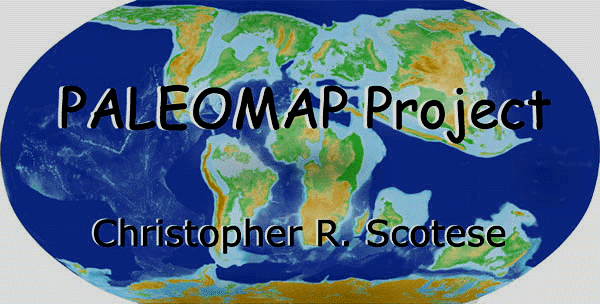
|
|
|
More Information About the Late Precambrian
The absence of fossils of hard-shelled organisms, and the paucity of reliable paleomagnetic data, make it difficult to produce paleogeographic maps for much of the Precambrian. With available data, 650 million years is about as far back as we can go. The late Precambrian, however, is an especially interesting time because the continents were colliding to form ancient supercontinents, and because the Earth was locked in a major Ice Age. About 1100 million years ago, the supercontinent of Rodinia was assembled. Though its exact size and configuration are not known, it appears that North America formed the core of this supercontinent. At that time, the east coast of North America was adjacent to western South America and the west coast of North America lay next to Australia and Antarctica. Rodinia split into 2 halves approximately 750 million years ago, opening the Panthalassic Ocean. North America rotated southwards towards the ice-covered South Pole. The northern half of Rodinia, composed primarily of Antarctica, Australia, India, Arabia, and the continental fragments that would one day become China, rotated counter-clockwise, northwards across the frigid, North Pole. Between the two halves of Rodinia lay a third continent - the Congo craton, made up of much of north-central Africa. It was caught in the middle as the two halves of Rodinia came crashing down on it. By the end of the Precambrian, about 550 million years ago, the three continents collided to form a new supercontinent called Pannotia. The mountain-building event associated with this collision is called the Pan-African orogeny. As mentioned previously, the global climate was cold during the Late Precambrian. Evidence of glaciation is found on nearly every continent. Why cold conditions were so widespread has puzzled geologists. Several hypotheses, have been proposed. One explanation suggests that the Earth was titlted sideways so that the North Pole faced towards the Sun, and the South Pole faced away from the Sun. This would have created a situation where 1/2 of the Earth would have broiled under the Sun for 6 months, while the other 1/2 of the Earth would have frozen solid. Though tantalizing, no mechanism can be found that would have produced such a drastic tilt of the Earth's axis. A second hypothesis proposes that the Earth was encircled by a rocky and icy ring, much like the rings of Saturn and Uranus. These rings would have cast a shadow on the Earth, cooling the climate. No trace of this ring, however, has been found. A third, and the most popular hypothesis, suggests that the Earth was completely frozen - oceans and all - like a giant snowball. The "Snowball Earth" hypothesis also explains anomalous isotopic signatures in overlying rocks. All of these hypotheses were put forward before there were accurate paleogeographic maps. The mystery of the Late Precambrian Ice House World can be better explained by the fact that during times of continental collision and supercontinent formation the world enters a global Ice House (like the present-day). The Late Precambrian Ice House world was very severe, because it just so happened that many continents were near either the North Pole or the South Pole. (The occurence of ice on Australia which was near the Equator is an interesting exception.) It should be pointed out that though much of the Earth was glaciated, there were regions near the equator that were ice free and enjoyed warm - if not balmly climates! Chart Summarizing Evolution of Atmosphere, Climate, and Life during the Precambrian. True Polar Wanders What caused the Late Precambrian Ice House World? Ediacara fauna Key References |